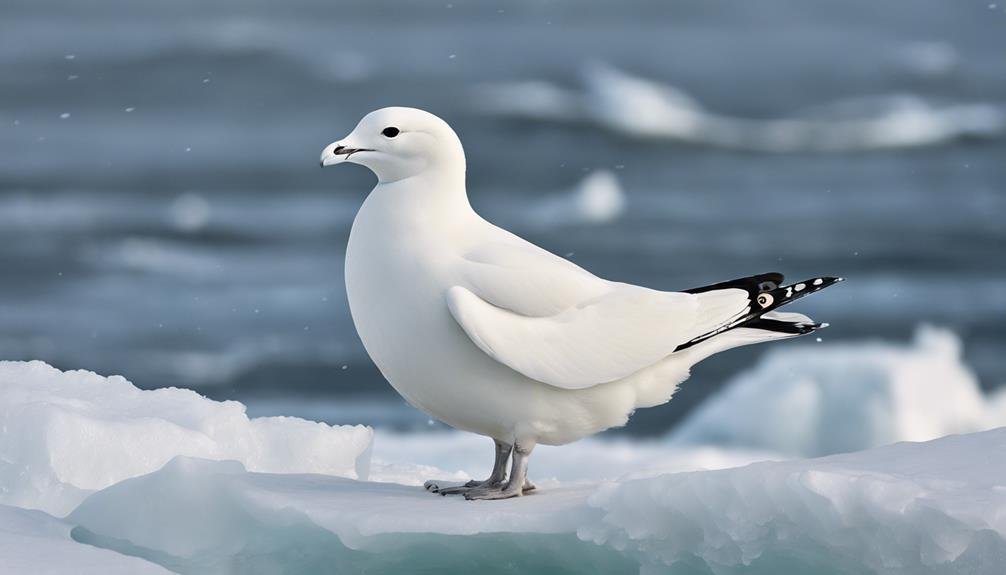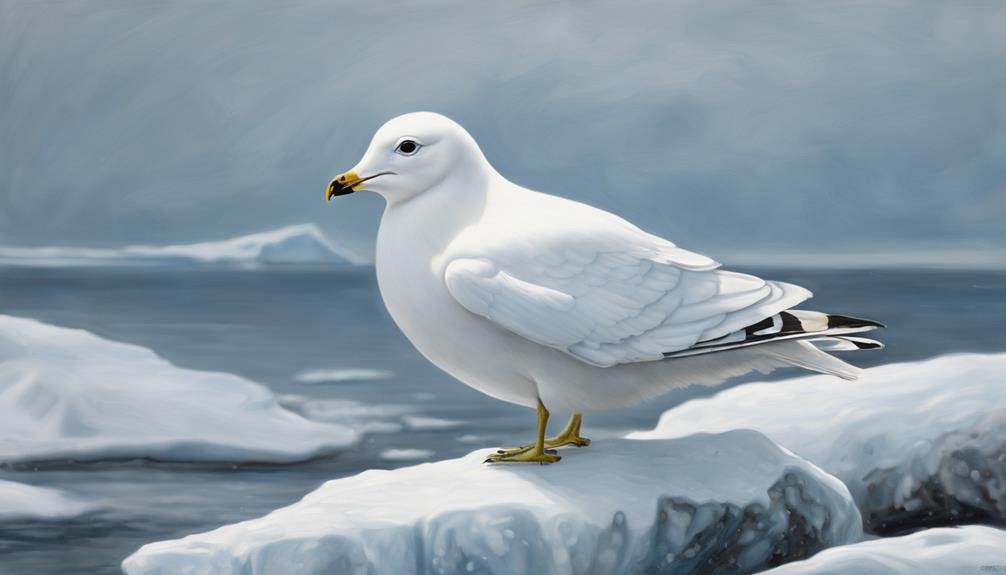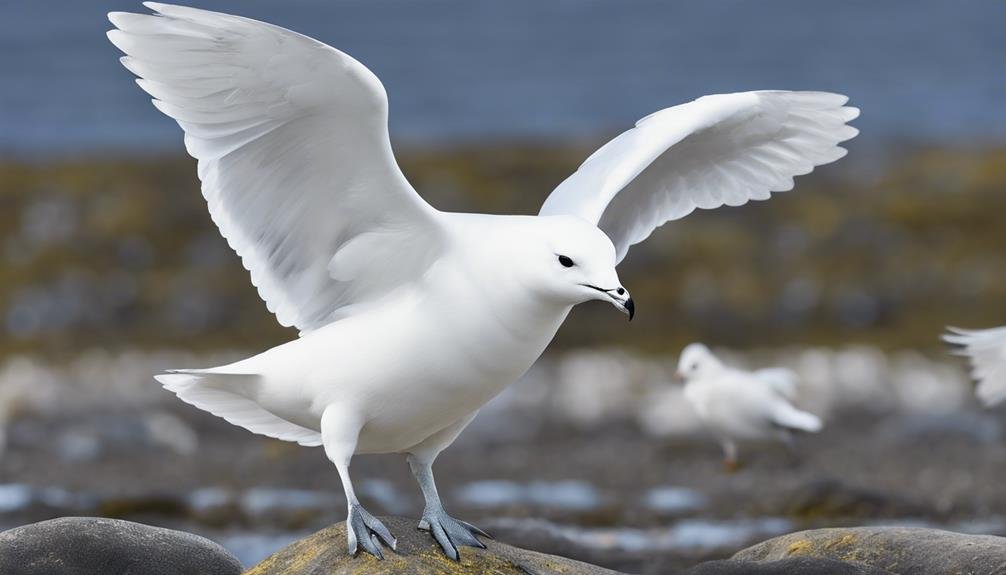Why is the Ivory Gull a subject of interest outside its Arctic domain? The answer lies in its exceptional adaptation to extreme conditions and its striking appearance. This bird, with its pure white feathers, not only captures attention for its beauty but also for its resilience and unique lifestyle.
The Ivory Gull represents a remarkable example of adaptation. This bird thrives in the frigid Arctic, showcasing a diet that includes fish and carrion, and exhibiting behaviors designed for survival in one of the planet’s most inhospitable environments. Its preference to avoid landing on water in freezing temperatures highlights its specialized adaptations.
Yet, with a global population estimated at only 45,000, the Ivory Gull is facing significant challenges. The dual threats of climate change and pollutants play a major role in the conservation issues confronting this species. These factors together underscore the urgent need for research and conservation efforts to secure the future of the Ivory Gull.
Key Takeaways
Key Takeaways:
- The Ivory Gull stands out with its pure white plumage and has adapted to thrive in the harsh High Arctic conditions.
- It faces severe threats from climate change and pollution, endangering its existence and habitat.
- With a global population estimated at 45,000, there’s an urgent need for conservation efforts to protect this species and its environment.
Scientific Classification
Johann Jakob Kaup’s Contribution to Avian Taxonomy
In the year 1829, Johann Jakob Kaup introduced a groundbreaking reclassification of the Ivory Gull, originally described under a different name. This bird, known for its stunning ivory-colored plumage, was first named Larus eburneus by Constantine Phipps in 1774. Recognizing the gull’s unique traits, Kaup established the new genus Pagophila, setting a precedent in avian classification that emphasized the importance of physical and ecological distinctiveness in categorizing species.
The Significance of ‘Pagophila alba’
The specific epithet ‘alba,’ assigned by Johan Ernst Gunnerus, plays a crucial role in highlighting the Ivory Gull’s affinity for icy habitats. This name, translating to ‘white,’ perfectly captures the essence of the bird’s appearance and its environment, reinforcing the link between nomenclature and natural history. The classification Pagophila alba not only marks the species’ preference for sea ice but also cements its identity within the broader context of Arctic wildlife.
Debates in Classification and the Unique Status of Pagophila
Despite ongoing discussions within the scientific community about potentially reclassifying the Ivory Gull into the genus Larus, the prevailing opinion supports the retention of Pagophila as a distinct genus. This decision underscores the gull’s specialized ecological niche and morphological characteristics, distinguishing it from its relatives. The genus Pagophila highlights the Ivory Gull’s unique position in the avian world, demonstrating the intricate relationship between species classification and understanding of biodiversity.
Habitat

Habitat Preferences of the Ivory Gull
Delving into the world of the Ivory Gull (Pagophila alba), it’s fascinating to observe their habitat choices, deeply intertwined with the Arctic’s stark landscapes. These birds thrive in conditions that many species would find inhospitable, showcasing their remarkable adaptability to the frigid extremes.
Drift Ice: A Floating Forage Ground
One of the most striking aspects of the Ivory Gull’s habitat is its reliance on drift ice. This icy platform serves as a critical foraging area, where the gulls can access marine life trapped within or beneath the ice. The presence of drift ice is a non-negotiable aspect of their survival, providing a unique ecosystem for their feeding habits.
Remote Nesting Areas: Seclusion for Breeding
When it comes to breeding, nesting areas are carefully selected for their remoteness and inaccessibility. These sites, far removed from human activity, offer the peace and security needed during the sensitive breeding season. The choice of such locations reflects the Ivory Gull’s need for solitude and safety, ensuring a higher chance of breeding success in the harsh Arctic environment.
Open Water: A Window to Feed
The significance of open water areas can’t be overstated. These patches of unfrozen sea amidst the ice are crucial feeding zones, providing the gulls with access to fish and other marine life. The ability to exploit these resources is a testament to the Ivory Gull’s resourcefulness and adaptability to the challenging Arctic conditions.
Bering Sea: A Crucial Migratory Pathway
The Bering Sea emerges as a vital checkpoint in the migratory routes of the Ivory Gull. Acting as a bridge between the nesting sites in the High Arctic and potentially more temperate zones, this area supports the gulls’ long journeys, offering resources to refuel and rest.
Rare sightings of the Ivory Gull beyond their usual Arctic confines, in places like California or New Jersey, spark intrigue and admiration among birdwatchers worldwide. These occasional ventures southward underscore the incredible migratory capabilities of the Ivory Gull and the enduring fascination they hold for bird enthusiasts. The adaptability and resilience of these Arctic navigators continue to capture the imagination, reminding us of the natural world’s wonders and mysteries.
Diet

Arctic Adaptations: The Diverse Diet of Ivory Gulls
In the harsh and icy expanses of the Arctic, the Ivory Gull thrives through a remarkable adaptability in its feeding habits. The secret to their resilience lies in a varied diet that includes fish, marine invertebrates, and carrion. These birds have developed a series of innovative foraging techniques to survive in one of the planet’s most extreme environments.
Foraging Techniques: Mastery over Land and Sea
Ivory Gulls are adept at exploiting their surroundings to find food. They hover gracefully before plunging into the cold waters to snatch up prey. On land, they wade and scavenge, proving their versatility. The gulls are also known to visit carcasses left behind by polar bears and other predators, showcasing their opportunistic nature.
Kleptoparasitism: A Strategy of Survival
A fascinating aspect of their behavior is kleptoparasitism. Ivory Gulls often steal food from other birds, demonstrating their cunning and resourcefulness. This strategy not only highlights their adaptability but also ensures they’ve access to a wider variety of food sources during lean times.
A Rich Menu: Beyond the Basics
The diet of Ivory Gulls is further enriched by larvae, squid, mollusks, and small crustaceans. These items are abundant in their Arctic habitat and provide the necessary nutrients to support their energy-intensive lifestyle. This diverse diet plays a critical role in the survival and thriving of Ivory Gulls in the Arctic’s demanding conditions.
Through these adaptive strategies and a diverse diet, Ivory Gulls exemplify the incredible resilience of wildlife in the face of extreme environmental challenges. Their ability to find and utilize a wide range of food sources is key to their survival in the Arctic.
Behaviour

Colony Dynamics and Nesting Practices:
Ivory Gulls are known for their social behaviors, including forming nesting colonies that can range significantly in size, with some of the largest colonies comprising up to 4,500 breeding pairs. This impressive gathering isn’t just about numbers; it’s a testament to their cooperative spirit. Each pair participates in communal activities such as constructing nests from available materials and ensuring the young are fed, showcasing their commitment to the community’s success.
The Rigors of Breeding:
The breeding season is a critical time for these gulls, where they demonstrate their dedication to the next generation. They meticulously prepare their nests and lay between one to three eggs, which are carefully tended to. The coloration of these eggs, ranging from brown to olive, may serve as a camouflage, protecting them from potential predators and increasing the chances of survival in the harsh Arctic environment.
Adaptive Feeding Strategies:
Ivory Gulls have developed unique strategies to survive in the Arctic’s unforgiving conditions. Their diet is varied and opportunistic, relying on the leftovers of Polar Bears or consuming the placenta and waste of seals and polar bears. Additionally, their ability to catch fish through hovering and plunging techniques further emphasizes their adaptability and resourcefulness, traits that are crucial for thriving in their icy habitat.
A Complex Social Hierarchy:
The establishment of colonies is more than just a survival strategy; it’s a reflection of the Ivory Gulls’ intricate social structure. Within these communities, cooperative behaviors flourish, enabling them to tackle the challenges of the Arctic together. This mutual support system is vital for their survival, ensuring that despite the extreme conditions, the species continues to thrive through a shared commitment to each other’s well-being.
Conservation

Urgent Conservation Measures for Ivory Gulls
The Ivory Gull’s social behavior and ability to adapt have highlighted their resilience. However, their existence is now threatened, demanding immediate action for their conservation. With a global population that’s dwindling, estimated at 19,000 to 27,000, the Ivory Gull faces serious threats from illegal hunting and the loss of sea ice, which is crucial for their feeding practices. This alarming decline has prompted the International Union for Conservation of Nature (IUCN) to list them as Near Threatened, underscoring the critical need for dedicated conservation efforts.
Dramatic Decline in Numbers Post-2007
Research has uncovered a disturbing sevenfold decrease in Ivory Gull numbers after 2007. The diminishing sea ice, vital for their feeding, adds to the dangers these birds encounter, further challenging their survival. In an effort to counter these threats, conservationists are employing tracking technology to monitor the gulls’ movements and health closely. This strategy is aimed at identifying and addressing threats promptly.
Collaborative Efforts to Safeguard Habitats
To combat the decline of the Ivory Gull, a coalition of governments, NGOs, and communities has been formed. This partnership focuses on preserving the Ivory Gull’s habitat and putting an end to illegal hunting. Through these collective actions, there’s hope to reverse the concerning trend in Ivory Gull populations and secure their existence amidst the challenges of a changing environment.
Climate Change Impacts

Impact on Habitat and Nesting Grounds
The rapid thawing of the Arctic ice poses a direct threat to the Ivory Gull’s living spaces. These birds rely on the ice for nesting and as a platform from which to launch their feeding expeditions. Shrinking ice sheets mean less available territory for these gulls, leading to overcrowded nesting sites and increased vulnerability to predators.
Challenges in Food Scarcity
As the Arctic’s icy terrains recede, the Ivory Gull faces a daunting challenge in finding enough food. This scarcity affects not just the adult gulls but also their chicks, who depend on a steady supply of food to survive their early stages. The reduction in ice affects the availability of fish and other marine life that form the gull’s primary diet, leading to lower breeding success rates.
Population Trends
The consequences of dwindling food supplies and habitat loss are reflected in the declining numbers of Ivory Gulls. This population decrease is a clear indicator of the struggles they face in an environment that’s rapidly changing due to climate effects. The reduction in numbers not only highlights their fight for survival but also raises concerns about the future viability of the species.
Altered Ecological Dynamics
Climate change disrupts the Arctic’s ecological equilibrium, impacting the Ivory Gull’s life cycle. Changes in temperature and ice cover affect migration routes, feeding areas, and timing of breeding. This disruption can lead to mismatches in food availability and breeding seasons, further complicating the survival of these gulls.
The Call for Conservation
Protecting the Ivory Gull requires immediate and sustained conservation efforts. Safeguarding the Arctic ecosystem and addressing the broader issue of climate change are vital steps in ensuring these birds have a fighting chance. The plight of the Ivory Gull serves as a stark reminder of the interconnectedness of ecosystems and the far-reaching effects of climate change.
Other Interesting Facts

Adaptations to Polar Life
The Ivory Gull stands out for its remarkable ability to adapt to the extreme conditions of its polar habitat. One of the most striking survival strategies these birds employ involves scavenging for the placenta of hooded seal pups. This behavior not only showcases their opportunistic feeding habits but also their ingenious ways of finding nutrition in environments where food sources are otherwise limited.
Unique Feeding Strategies in Harsh Winters
Researchers have observed an intriguing aspect of Ivory Gull behavior: their tendency to peck at red objects. This includes items such as clothing, which sparks curiosity about how these birds perceive and interact with their surroundings. This peculiar behavior opens up discussions on the sensory perceptions of Ivory Gulls and their cognitive responses to colors in their environment.
Curious Interactions with the Color Red
Another fascinating adaptation of the Ivory Gull is its avoidance of landing in water when air temperatures drop below freezing. This behavior underscores their incredible adaptability to the frigid conditions of the polar regions. It reflects a keen sense of self-preservation and an innate understanding of the risks posed by their icy habitat.
Adapting to Freezing Temperatures
The Ivory Gull is also known for its impressive longevity, with records of individuals living to at least 23 years and 11 months. Sightings of these birds far from their typical High Arctic domains, in places such as California or New Jersey, highlight their extraordinary migratory capabilities. These occurrences excite birding communities and underscore the Ivory Gull’s adaptability to traverse vast distances.
Remarkable Longevity and Unexpected Journeys
What Are the Similarities and Differences Between Ivory Gulls and Red Phalaropes?
The ivory gull and red phalarope have some similarities and differences. Both are Arctic birds but the ivory gull primarily feeds on carrion and waste, while the red phalarope hunts for small fish and invertebrates. Additionally, red phalarope fun facts include their amazing ability to swim and forage in rough seas.
Frequently Asked Questions
What Are Some Interesting Facts About Ivory Gulls?
Q: Where do Ivory Gulls live?
A: Ivory Gulls inhabit Arctic habitats, thriving in cold environments.
Q: What is unique about Ivory Gulls’ appearance?
A: They are known for their striking white plumage, which helps them blend in with their icy surroundings.
Q: How do Ivory Gulls communicate?
A: They use distinct vocal communications to interact with each other, especially during breeding season.
Q: What challenges are Ivory Gulls facing?
A: Climate impact is a significant threat, affecting their nesting behaviors, migration patterns, and reducing their overall population.
What Does an Ivory Gull Eat?
What does an ivory gull eat?
An ivory gull primarily consumes fish, marine invertebrates, and carrion. They adapt their feeding strategies to the changing seasons, engaging in scavenging and opportunistic theft to fulfill their dietary needs. This diet allows them to thrive in their harsh Arctic environment by utilizing a wide range of food sources.
How Rare Is the Ivory Gull?
Q: How rare is the Ivory Gull?
A: The Ivory Gull is considered relatively rare due to its “Near Threatened” status, confined habitat range primarily in the Arctic, and a small global population. Their rarity is further highlighted during migration periods, where they can be observed in specific locations, underscoring the significant impact of climate change and other threats on their numbers.
Are Ivory Gulls Carnivores?
Q: Are Ivory Gulls Carnivores?
A: Yes, Ivory Gulls are carnivores. They primarily consume fish and carrion in the Arctic regions. Their diet influences their nesting sites, migration habits, and reproductive patterns. Additionally, climate change is a significant threat to their survival and conservation efforts.
What Are the Key Differences in Habitat Between King Eiders and Ivory Gulls?
King Eiders and Ivory Gulls thrive in different Arctic habitats. While King Eiders tend to favor coastal waters and breed in tundra ponds, Ivory Gulls prefer icy sea regions. For detailed king eider information, understanding their nesting preferences and foraging habits in comparison to other Arctic species is essential.
Conclusion
Summarizing the key aspects of the Ivory Gull’s life and the challenges it faces, this bird is a remarkable species distinguished by its pure white feathers and specialized feeding strategies. It thrives in the extreme conditions of the High Arctic, showcasing a remarkable resilience.
However, the Ivory Gull is confronted with dire threats such as climate change and pollution, which pose significant risks to its habitat and way of life. With an estimated global population of about 45,000, the urgency for conservation efforts is apparent.
Protecting the Ivory Gull requires proactive measures to mitigate environmental threats, safeguarding not only this unique bird but also the delicate ecosystem it inhabits.


